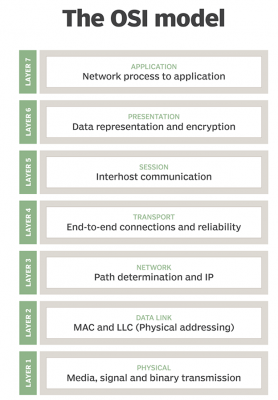Layered Network Model
- Networking models describe networking
should work and 2 models
are
- OSI Model
- TCP/IP Model
- Model defines a networking framework for implementing protocols in different layers.
- Control moves between layers, from one to next
- starting at top most layer to bottom layer
- over physical channel to next station on network, and then back as per hierarchy.
Layering Concepts and Benefits
- Interoperability – interoperability between devices from different manufacturers.
- Compatibility – devices/systems /networks should be compatible
- Better Flexibility – flexibility in options and choices for configuration and installation.
- Increased Life Expectancy – Devices from different technology generations can co-exist thus the older units do not get discarded immediately newer technologies are adopted.
- Scalability – Experience shows that a layered design scales better than the horizontal approach.
- Modularity Plug-ins and add-ons are easily added from use of a layered approach.
- Standardization and Certification –easy compliance ot standards and according certification for use by end users.
- Portability – Layered networking protocols are much easier to port from one system to another.
OSI Basics
- The ISO or International Standards Organization, has defined a 7-layer model for standardizing networking processes.
- 7 Layers are
- Physical Layer
- Data Link Layer
- Network Layer
- Transport Layer
- Session Layer
- Presentation Layer
- Application Layer

Physical Layer
- lowest layer of the OSI mode
- about transmission and reception of the raw bit stream over physical medium like wire, air
- describes electrical/optical, mechanical, and functional interfaces to physical medium
- carries signals for all higher layers.
- It provides
- Data encoding – digital signal to characteristics of physical medium
- Transmission technique
- transmits digital bits as electrical or optical signals on the physical medium
Data Link Layer
- It gives error-free data frames transfer from one node to another over the physical layer
- Provides top layers an error-free transmission over the link.
- It provides
- Link establishment and termination
- Frame traffic control
- Frame sequencing
- Frame acknowledgment
- Frame delimiting
- Frame error checking
- Media access management
Network Layer
- controls operation of subnet
- decides which physical path data should take based on
- network conditions
- priority of service
- and other factors
- It provides
- Routing
- Subnet traffic control
- Frame fragmentation
- Logical-physical address mapping
- Subnet usage accounting
Transport Layer
- ensures messages are delivered
- error-free
- in sequence
- no losses or duplications
- relieves higher layer from concern of data transfer
- In a reliable network layer with virtual circuit capability, a minimal transport layer is required
- unreliable one needs datagrams
- include extensive error detection and recovery
- It provides
- Message segmentation
- Message acknowledgment
- Message traffic control
- Session multiplexing
- strict message size limits are imposed
Session Layer
- It allows session establishment between processes running on different nodes
- It provides
- Session establishment, maintenance and termination
- Session support
Presentation Layer
- It formats data to be presented to the application layer
- translate data from application layer format into a common format at the source
- It provides
- Character code translation
- Data conversion
- Data compression
- Data encryption
Application Layer
- It serves as window for users and application processes to access network services.
- It has functions
- Resource sharing and device redirection
- Remote file access
- Remote printer access
- Inter-process communication
- Network management
- Directory services
- Electronic messaging (such as mail)
- Network virtual terminals
TCP/IP
- Also called, Internet protocol suite
- It was in use before OSI model was established
- Facilitates end-to-end connectivity
- Also specify data should be
- Formatted
- Addressed
- Transmitted
- routed
- received at the destination.
- It is maintained by the (IETF) or Internet Engineering Task Force.
- has 4 abstraction layers, every layer has own protocols.
- From highest to lowest, the layers are
- Application layer (process-to-process)- Has all higher level protocols (like FTP, HTTP) for specific data communications services on a process-to-process level
- Transport layer (host-to-host)- deals with opening and maintaining connections between Internet hosts. It does flow-control, error-correction, and connection protocols exist, such as TCP.
- Internet layer (internetworking)- connects local networks, and establish internetworking. Defines addressing and routing structures. Has Internet Protocol or IP, which defines IP addresses.
- Link layer- Also called Ethernet. Has communication technologies for a local network. Defines hosts communication on local network without routers.
AWS Certified Advanced Networking Specialty Free Practice TestTake a Quiz
